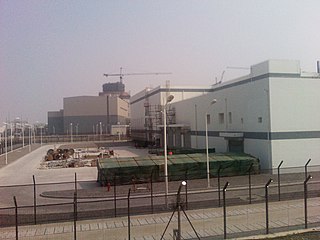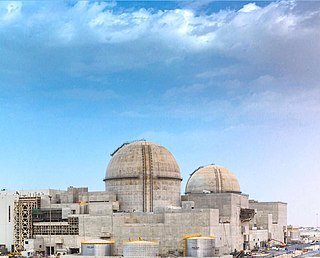Related Research Articles

The AP1000 is a nuclear power plant designed and sold by Westinghouse Electric Company. The plant is a pressurized water reactor with improved use of passive nuclear safety and many design features intended to lower its capital cost and improve its economics.

The China National Nuclear Corporation is a state-owned enterprise founded in 1955 in Beijing. CNNC's president and vice-president are appointed by the Premier of the People's Republic of China. CNNC oversees all aspects of China's civilian and military nuclear programs. According to its own mission statement, it "is a main part of the national nuclear technology industry and a leading element of national strategic nuclear forces and nuclear energy development."
The Chashma Nuclear Power Plant is a large commercial nuclear power plant located at Chashma in Mianwali, Punjab, Pakistan.
As of 2022, nuclear power is provided by six commercial nuclear power plants in Pakistan. Pakistan is the first Muslim majority country in the world to construct and operate civil nuclear power plants. The Pakistan Atomic Energy Commission (PAEC), the scientific and nuclear governmental agency, is solely responsible for operating these power plants. As of 2018, the electricity generated by commercial nuclear power plants constitutes roughly 7.5% of electricity generated in Pakistan, Pakistan is not a party to the Nuclear Non-Proliferation Treaty but is a member of the International Atomic Energy Agency. Pakistan plans on constructing 32 nuclear power plants by 2050 and envisions 40,000 MW of nuclear power generation.
Ling Ao Nuclear Power Plant (岭澳核电站) is located on the Dapeng Peninsula in Longgang District, Shenzhen, Guangdong, China, about 60 km north of Hong Kong, 1 km north of Daya Bay Nuclear Power Plant. It is operated by China General Nuclear Power Group. The units on site are separated between phase I and phase II.

China is one of the world's largest producers of nuclear power. The country ranks third in the world both in total nuclear power capacity installed and electricity generated, accounting for around one tenth of global nuclear power generated. As of February 2023, China has 55 plants with 57GW in operation, 22 under construction with 24 GW and more than 70 planned with 88GW. About 5% of electricity in the country is due to nuclear energy. These plants generated 417 TWh of electricity in 2022 This is versus the September 2022 numbers of 53 nuclear reactors, with a total capacity of 55.6 gigawatt (GW). In 2019, nuclear power had contributed 4.9% of the total Chinese electricity production, with 348.1 TWh.

Tianwan Nuclear Power Plant is a nuclear power plant (NPP) on the coast of the Yellow Sea, approximately 30 kilometers east of downtown Lianyungang, Jiangsu Province, China. The plant's owner is Jiangsu Nuclear Power Corporation, a joint venture with majority owner a subsidiary of China National Nuclear Corporation (CNNC).

The Sanmen Nuclear Power Station is a nuclear power station in Sanmen County, Zhejiang, China. Sanmen is the first implementation of the AP1000 pressurized water reactor (PWR) developed by Westinghouse Electric Company.
Fangjiashan Nuclear Power Plant (方家山核电站) is a nuclear power plant in the Zhejiang province, China, bordering the Shanghai municipality. The plant consists of two 1,080 MW CPR-1000 pressurized water reactors (PWR) at a total cost of estimated 26 billion yuan.
China General Nuclear Power Group (CGN), formerly China Guangdong Nuclear Power Group (中国广东核电集团), is a Chinese state-owned energy corporation under the SASAC of the State Council.
Changjiang Nuclear Power Plant is a nuclear power plant in Tangxing Village of Haiwei Township, Changjiang Li Autonomous County in the province of Hainan. It is the first power plant of its kind in the province.
The CPR-1000, or CPR1000 is a Generation II+ pressurized water reactor, based on the French 900 MWe three cooling loop design (M310) imported in the 1980s, improved to have a slightly increased net power output of 1,000 MWe and a 60-year design life.
The BN-800 reactor is a sodium-cooled fast breeder reactor, built at the Beloyarsk Nuclear Power Station, in Zarechny, Sverdlovsk Oblast, Russia. The reactor is designed to generate 880 MW of electrical power. The plant was considered part of the weapons-grade Plutonium Management and Disposition Agreement signed between the United States and Russia. The reactor is part of the final step for a plutonium-burner core The plant reached its full power production in August 2016. According to Russian business journal Kommersant, the BN-800 project cost 140.6 billion rubles.

The APR-1400 is an advanced pressurized water nuclear reactor designed by the Korea Electric Power Corporation (KEPCO). Originally known as the Korean Next Generation Reactor (KNGR), this Generation III reactor was developed from the earlier OPR-1000 design and also incorporates features from the US Combustion Engineering (C-E) System 80+ design. Currently in South Korea there are 3 units in operation, and 3 units in construction. Three units are completed and in commercial operation in the United Arab Emirates at Barakah, with one more under construction at the same plant.

The Hualong One is a Chinese Generation III pressurized water nuclear reactor jointly developed by the China General Nuclear Power Group (CGN) and the China National Nuclear Corporation (CNNC). The CGN version, and its derived export version, is called HPR1000. It is commonly mistakenly referred to in media as the "ACPR1000" and "ACP1000", which are in fact earlier reactors design programs by CGN and CNNC.
The CFR-600 is a sodium-cooled pool-type fast-neutron nuclear reactor under construction in Xiapu County, Fujian province, China, on Changbiao Island. It is a generation IV demonstration project by the China National Nuclear Corporation (CNNC). Construction started in late 2017. These reactors are expected to be connected to the grid in 2023 and 2025. The reactor will have an output of 1500 MW thermal power and 600 MW electric power. The fuel will be supplied by TVEL, subsidiary of Rosatom, according to the agreement signed in 2019.
The CNP-300 is a pressurized water nuclear reactor developed by the China National Nuclear Corporation (CNNC).
The CNP Generation II nuclear reactors were a series of nuclear reactors developed by China National Nuclear Corporation (CNNC), and are predecessors of the more current Hualong One design.
References
- ↑ Biello, David (29 March 2011). "China forges ahead with nuclear energy". Nature. doi:10.1038/news.2011.194 . Retrieved 28 May 2018.
- ↑ "China's commercial reactors" (PDF). Nuclear Engineering International. Retrieved 29 May 2018.
- ↑ (IAEA), International Atomic Energy Agency. "- Nuclear Power - IAEA". www.iaea.org. Retrieved 29 May 2018.
- ↑ "Chinese reactor design evolution - Nuclear Engineering International". www.neimagazine.com. Retrieved 29 May 2018.